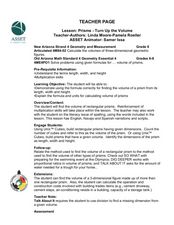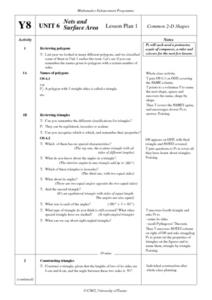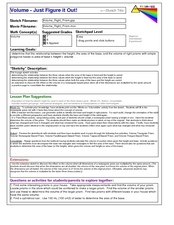Learner
Solid Shapes
A collection of two lessons, kindergartners will identify two-dimensional shapes in solid shapes. They will develop basic knowledge of the components that make up a sphere, rectangular prism, pyramid, cylinder, cone, and cube. Young...
Curated OER
Prisms-Turn Up The Volume
Identify the length, width, and height of prisms. Critical thinkers calculate the volume of prisms given small amounts of information. They derive the formula given the length, width and height.
Curated OER
Volume, Surface Area for Rectangular & Triangular Prisms
Seventh graders explore the concept of rectangular and triangular prisms. In this rectangular and triangular prism lesson, 7th graders identify various prisms as triangular or rectangular. Students discuss the various shapes of bases...
Curated OER
Two for One Box Company: Student Worksheet
Fifth and sixth graders work alone or in pairs to determine the volume of paper boxes of various dimensions. Pupils write ratios of dimensions and volumes.
Curated OER
New Boxes From Old
Students find the volume and surface area of a rectangular box (e.g., a cereal box), and then figure out how to convert that box into a new, cubical box having the same volume as the original. As they construct the new, cube-shaped box...
Curated OER
Unit 22: Volume
In this volume instructional activity, students determine the volume of rectangular prisms. Students examine diagrams, tables and short story problems to determine information needed to find the volume. This ten-page instructional...
Curated OER
Volumes
In this volume instructional activity, 6th graders solve 5 different problems related to determining the volume of various objects. They determine the volume of a rectangular prism, a cone, a cube, a pyramid, and a cylinder.
Illustrative Mathematics
Computing Volume Progression 1
Finding the volume of a right rectangular prism is the focus of the resource. Worksheet includes a drawing of a cube to help learners visualize the concept. Young geometers will learn that as the side length increases, so does the...
Curated OER
Surface Area Formulas
In this geometry worksheet, students complete 21 problems where they find the surface area of pyramids, cubes, and rectangular prisms. This excellent worksheet would be an ideal quiz, or homework assignment.
Curated OER
Finding Volume of Similar Figures
Upper elementary and middle schoolers examine the Volumes of Similar Figures. They investigate the relationship between corresponding sides and evaluate the volume of similar figures. Pupils record their findings on various activity...
Curated OER
Recognizing 3-D Shapes, Part 2
Take your math lesson to another dimension with this lesson about 3-D shapes! First graders label cones, cylinders, pyramids, spheres, cubes, and prisms, and then count the number of each shape in a collective picture. A great way to...
Curated OER
Volume of Solids: Algebra/Geometry Institute
Use this volume of solids lesson plan to have learners find the surface area and volume of cylinders, pyramids, and prisms. They place cubes inside three-dimensional figures to determine the volume. Worksheets and answers are provided.
Illustrative Mathematics
Christo’s Building
Hook your charges on how to solve a real-world art problem with mathematics by showing works of Christo. You can find eye-catching images on the Christo and Jeanne Claude webpage. Here, math learners help Jean Claude and Christo prepare...
Curated OER
3-D Attributes
Students explore geometric solids. In this geometry instructional activity, students listen to the book The Greedy Triangle by Marilyn Burns, then work in groups to sort geometric solids into various categories. Students define geometric...
Curated OER
Volume of a Cube without a Picture
In this geometry worksheet, students draw and calculate the volume of a cube from the given side length measured in metric or customary. There are 8 questions with provided workspace.
Curated OER
Nets And Surface Area
Upper graders investigate how to find the surface area when using two-dimensional shapes. They conduct an investigation in groups while working sample problems given during class discussion with the teacher. They also review how to...
Curated OER
Volume
In this volume worksheet, students determine the number of cuboids needed to create a rectangular prism of a particular size. They determine the mass, volume and density of cereal boxes. Students determine the volume of rectangular...
Noyce Foundation
Building Blocks
Building blocks have more uses than simply entertaining children. Young mathematicians calculate the volume of a given cube, and then calculate the volume and surface area of a prism formed from multiple cubes.
Curated OER
How many edges do I need to cut in order to open a cube?
Students problem solve to open a cube to create different shapes. In this problem solving lesson plan, students are given a cube and the shapes to open it up to, and they have to cut the cube open to make certain shapes. This gives them...
Curated OER
Volume of Prisms
Students calculate the volume of different polygons. For this geometry lesson, students identify the relationship between base and height. They calculate the area of each prism and cylinder.
Curated OER
Volume
In this volume worksheet, 8th graders solve and complete 6 different short answer questions and problems that relate to volume. First, they determine the number of cubes found altogether that has a given length, width and height. Then,...
Curated OER
Perimeter, Area, Volume and Surface Area
In this perimeter of shapes learning exercise, 10th graders find the perimeter of the shapes illustrated. Then, they find the volume of each shape shown. Students also match the shape with its correct name on the left and find the...
Curated OER
Opening A Cube
Fifth graders investigate mathematical concepts related to the construction of a three dimensional cube. They construct the cube from two dimensional patterns and compute the surface area. Students also define the faces, edges, and...
Curated OER
Classify Prisms
Students classify prisms according to their attributes. In this classifying prisms lesson, students explore different prisms. Students generate observations of the attributes and classify the prism correctly.

























